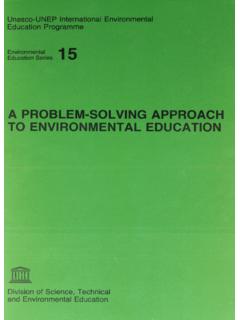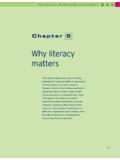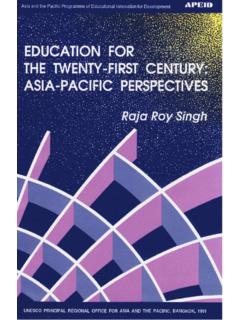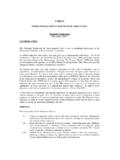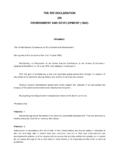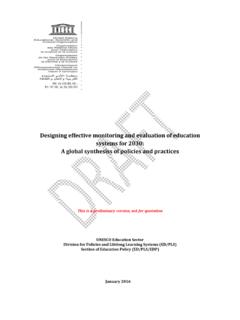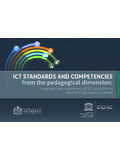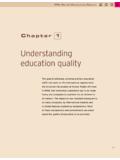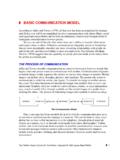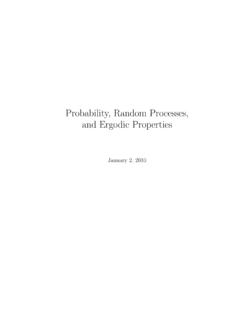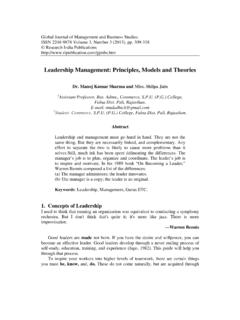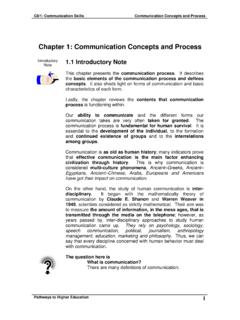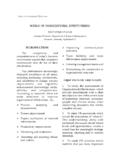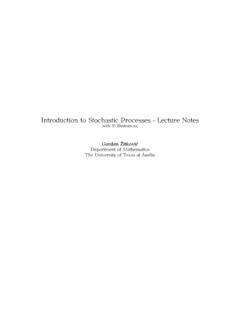Transcription of Approaches to Development Communication - UNESCO
1 Approaches toDevelopment CommunicationJan Servaes (ed.)Paris: UNESCO2002 Servaes, J. (ed.) (2002). Approaches to Development Communication , Paris: of ContentsBy Way of IntroductionJAN SERVAESI . and the Persistence of Poverty: The Needfor a Return to BasicsPRADIP Interactions. Human Rights and Development inCultural PerspectiveJAN SERVAES & CHRIS Globalization through LocalizationJAN SERVAES & RICO Minds versus Horizontal Cultures. An Overview ofParticipatory Processes and ExperiencesALFONSO GUMUCIO DAGRONII. The Theoretical Underpinnings of Approaches toDevelopment Panoptic View: A Discourse Approach toCommunication and DevelopmentSUJATHA SOSALEAPPROACHES TO Development COMMUNICATIONTABLE OF CONTENTS PAGE of Development CommunicationROYAL Communication Approaches in anInternational PerspectiveJAN SERVAES & PATCHANEE the History of Participatory CommunicationApproaches to Development : A Critical AppraisalROBERT HUESCAIII.
2 Communication Policies, Strategies and for Development Approaches of SomeGovernmental and Non-Governmental AgenciesJAN s Contributions to Cultural Diversity andCommunication for Communication and Adult Learning for RuralDevelopment: Three Decades of FAO ExperienceGARY COLDEVIN IN COLLABORATION WITH THECOMMUNICATION FOR Development GROUP OF THE FAOAPPROACHES TO Development COMMUNICATIONTABLE OF CONTENTS PAGE People, Evolving Behaviour: The UNICEFE xperienceNEILL MCKEE, ERMA MANONCOURT, CHIN SAIK YOON &RACHEL in HIV/AIDS Prevention. Building on theSoul City Experience in South AfricaTHOMAS TUFTEV. More Complexity and Specificity Development and the InternetRICO Community Media WorkNICO CARPENTIER, RICO LIE & JAN and Ethnopolitical ConflictGEORGIOS TERZISB asic BibliographyRICO LIE & JAN SERVAESA bout the AuthorsSERVAES, J.
3 (2002). By Way of Introduction. In: SERVAES, J. (ed.), Approaches to Development Communication , Paris: Way of IntroductionJan ServaesResearch Center Communication for Social Change (CSC), BrusselAll those involved in the analysis and application of communicationfor Development - or what can broadly be termed developmentcommunication - would probably agree that in essencedevelopment Communication is the sharing of knowledge aimed atreaching a consensus for action that takes into account theinterests, needs and capacities of all concerned. It is thus a socialprocess. Communication media are important tools in achievingthis process but their use is not an aim in itself interpersonalcommunication too must play a fundamental basic consensus on Development Communication has beeninterpreted and applied in different ways throughout the pastcentury.
4 Both at theory and research levels, as well as at the levelsof policy and planning-making and implementation, divergentperspectives are on the research and theory level this could easily be illustrated asfollows:In her PhD-thesis Jo Ellen Fair (summarized in the journal Gazette,1989) examined 224 studies of Communication and developmentpublished between 1958 and 1986, and found that modelspredicting either powerful effects or limited effects informed Communication in the 1958-1986 period wasgenerally greeted with enthusiasm and optimism: CommunicationJAN SERVAESBY WAY OF INTRODUCTION PAGE 2has been a key element in the West s project of developing theThird World. In the one-and-a-half decades after Lerner sinfluential 1958 study of Communication and Development in theMiddle East, Communication researchers assumed that theintroduction of media and certain types of educational, political,and economic information into a social system could transformindividuals and societies from traditional to modern.
5 Conceived ashaving fairly direct and powerful effects on Third World audiences,the media were seen as magic multipliers, able to accelerate andmagnify the benefits of Development . Three directions for future research were suggested: to examinethe relevance of message content, to conduct more comparativeresearch, and to conduct more policy a follow-up to this research, Jo Ellen Fair and Hemant Shah(1997) studied 140 journal articles, book chapters and bookspublished in English between 1987 and 1996. Their findings arequite illuminating: In the 1987-1996 period, Lerner smodernization model completely disappears. Instead, the mostfrequently used theoretical framework is participatorydevelopment, an optimist postmodern orientation, which is almostthe polar opposite of Lerner who viewed mass Communication asplaying a top-down role in social change.
6 Also vanishing fromresearch in this latter period is the two-step flow model , which wasdrawn upon by modernization scholars .. Both periods do makeuse of theories or Approaches such as knowledge gap, indirectinfluence, and uses and gratifications. However, researchappearing in the years from 1987-1996 can be characterized asmuch more theoretically diverse than that published between1958-1986 (Fair & Shah, 1997:10).JAN SERVAESBY WAY OF INTRODUCTION PAGE 3In the 1987-1996 study, the most frequent suggestion was theneed to conduct more policy research, including institutionalanalysis of Development agency coordination. This was followed bythe need to research and develop indigenous models ofcommunication and Development through participatory research (Fair & Shah, 1997:19).
7 Therefore, today almost nobody would dare to make the optimisticclaims of the early years any longer. However, the implicitassumptions on which the so-called dominant modernizationparadigm is built do still linger on and continue to influence thepolicy and planning-making discourse of major actors in the field ofcommunication for Development , both at theoretical and Modernization, over Dependency, toMultiplicityAfter the Second World War, the founding of the United Nationsstimulated relations among sovereign states, especially the NorthAtlantic Nations and the developing nations, including the newstates emerging out of a colonial past. During the cold war periodthe superpowers the United States and the former Soviet Union tried to expand their own interests to the developing countries.
8 Infact, the USA was defining Development and social change as thereplica of its own political-economic system and opening the wayfor the transnational corporations. At the same time, thedeveloping countries saw the welfare state of the North AtlanticNations as the ultimate goal of Development . These nations wereattracted by the new technology transfer and the model of acentralized state with careful economic planning and centrallydirected Development bureaucracies for agriculture, education andJAN SERVAESBY WAY OF INTRODUCTION PAGE 4health as the most effective strategies to catch up with thoseindustrialized mainly economic-oriented view, characterized by endogenismand evolutionism, ultimately resulted in the modernization andgrowth theory. It sees Development as an unilinear, evolutionaryprocess and defines the state of underdevelopment in terms ofobservable quantitative differences between so-called poor and richcountries on the one hand, and traditional and modern societies onthe other hand (for more details on these paradigms, see Servaes1999).
9 As a result of the general intellectual revolution that took place inthe mid 60s, this Euro- or ethnocentric perspective ondevelopment was challenged by Latin American social scientists,and a theory dealing with dependency and underdevelopment wasborn. This dependency approach formed part of a generalstructuralist re-orientation in the social sciences. The dependistas were primarily concerned with the effects of dependency inperipheral countries, but implicit in their analysis was the idea thatdevelopment and underdevelopment must be understood in thecontext of the world dependency paradigm played an important role in themovement for a New World Information and Communication Orderfrom the late 1960s to the early 1980s. At that time, the newstates in Africa, Asia and the success of socialist and popularmovements in Cuba, China, Chile and other countries provided thegoals for political, economic and cultural self-determination withinthe international community of nations.
10 These new nations sharedthe ideas of being independent from the superpowers and movedto form the Non-Aligned Nations. The Non-Aligned Movementdefined Development as political SERVAESBY WAY OF INTRODUCTION PAGE 5 Since the demarcation of the First, Second and Third Worlds hasbroken down and the cross-over center-periphery can be found inevery region, there is a need for a new concept of developmentwhich emphasizes cultural identity and multidimensionality. Thepresent-day global world, in general as well as in its distinctregional and national entities, is confronted with multifacetedcrises. Apart from the obvious economic and financial crisis, onecould also refer to social, ideological, moral, political, ethnic,ecological and security crises. In other words, the previously helddependency perspective has become more difficult to supportbecause of the growing interdependency of regions, nations andcommunities in our so-called global the criticism of the two paradigms above, particularly that ofthe dependency approach, a new viewpoint on Development andsocial change has come to the forefront.

